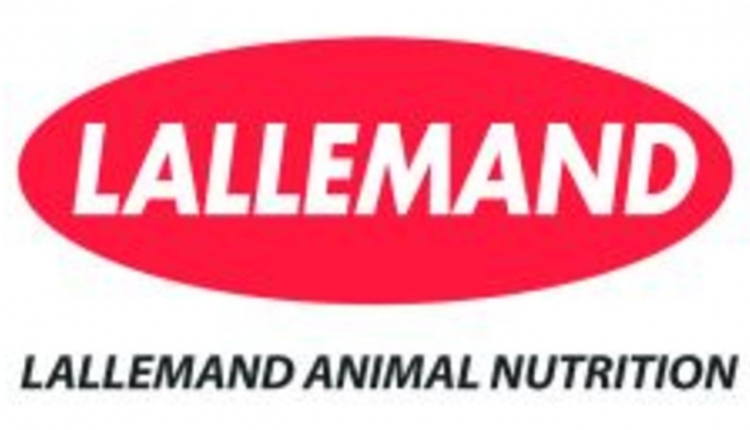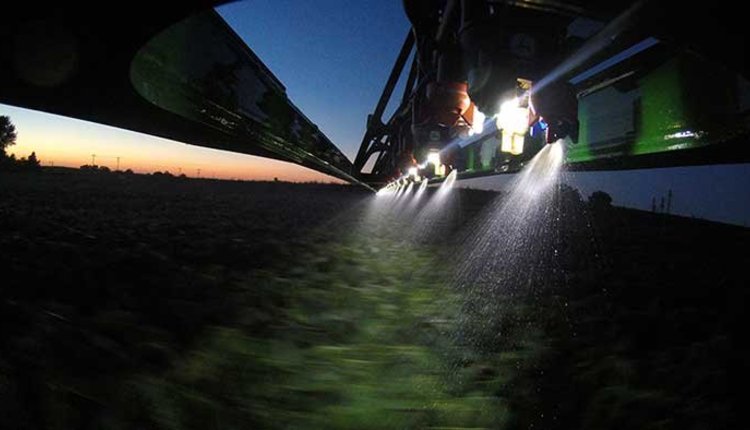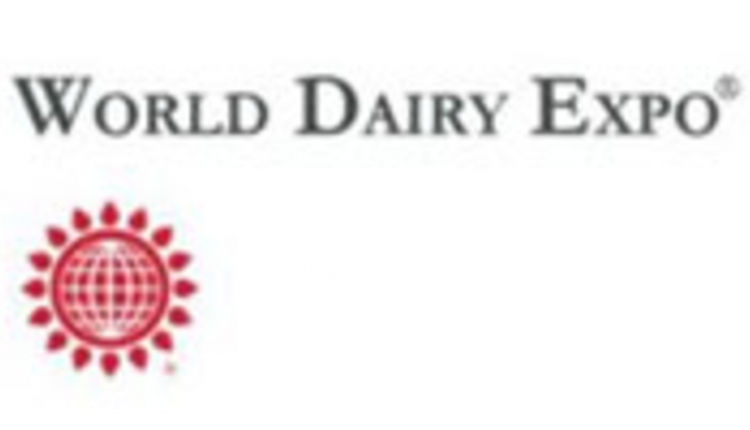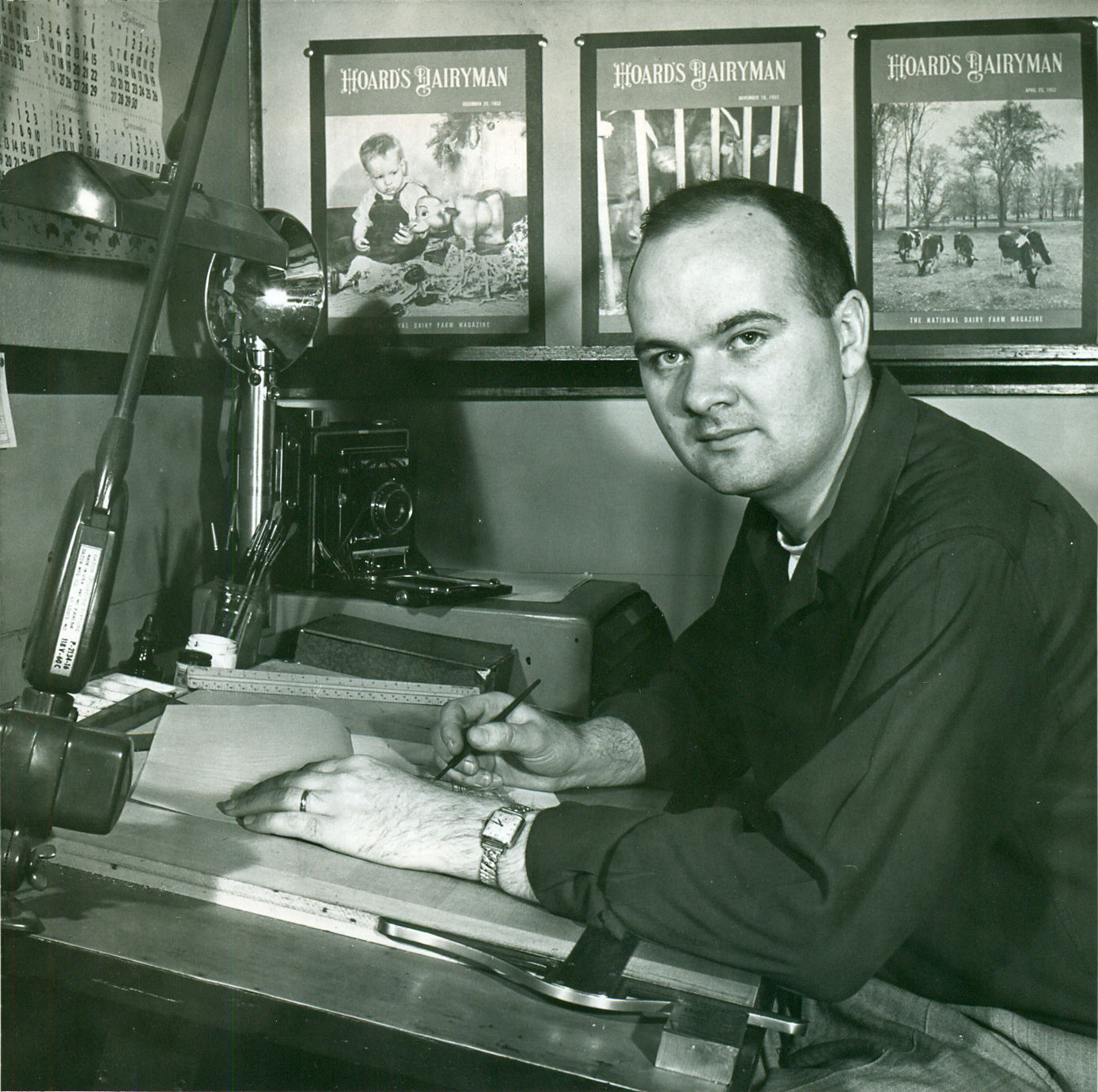
A Fort Atkinson man who helped shape the dairy industry one drawing at a time has passed away.
James S. Baird, who served as the art director of Hoard's Dairyman magazine for 44 years, died Monday, Jan. 25, at St. Mary's Hospital in Madison following complications from a heart attack. He was 86 years old.
Born in Kenosha in 1929 and brought up in Burlington, Baird moved with his parents to Fort Atkinson when he was a high school freshman, graduating from Fort Atkinson High School in 1947.
Most of Baird's artistic skills were self-taught. As a high school junior, he won honors with a pen-and-ink drawing in a national art competition conducted by the Carnegie Institute in Pittsburgh.
He did, however, receive invaluable experience from working during the summer, after school and on weekends in the art department at James Manufacturing Co. He was under the direction of commercial artist Gilbert Knoerr, whom Baird credited with having an influence on his work.
Baird attended Whitewater State Teachers College, now the University of Wisconsin-Whitewater, for one year. Influenced by Leon Pescheret, a notable etcher in Whitewater, with whom Baird studied during college and after, he took some courses at Layton Art School in Milwaukee and received camera tips by his father, an amateur photographer.
Baird had completed just one year of college when William D. Hoard Jr. recruited Baird to Hoard's Dairyman magazine in Fort Atkinson.
Hoard had heard about Baird's talent from friends who had seen his work at local art exhibits. He was impressed during the interview, but made one simple request:
"Jim, please don't get too darn arty."
Baird agreed and started work March 18, 1948. He remained at W.D Hoard &?Sons Co. for the next four decades.
At the time of Baird's retirement on Dec. 31, 1993, then-company President William D. Knox cited Baird's perfectionism that pervaded his work since his first day on the job 44 years before.
"He joined us with very limited photographic arts experience and went on to become one of the nation's leading agricultural photographers," Knox said of Baird. "It was his personal perseverance and a penchant for perfection that made him a great photographer."
Baird recalled during a retirement interview that when he was hired, the magazine was printed on letterpress and all the graphics and layout were done by hand. The magazine moved to offset printing around 1973, and then suddenly, things could be rapidly copied and created by a camera.
To Baird, that meant less actual drawing and more photography. After a while, he was taking a lot of the cover photos for the magazine, a task that sent him to 37 different states over the years.
In fact, Baird's photos of cattle and dairies appeared on some 700 of the magazine's covers and were seen by hundreds of thousands of milk producers around the world.
"We had very specific rules for covers," Baird said, looking back on his career. "Each cover had to have a cow in it. We didn't show cows standing in water because that leads to pollution. Cows had to be clean. And cows had to be of one breed."
He added, "I can remember times shooing a cow away. Today, many herds have mixed breeds, so that rule has changed."
Baird always carried two cameras - one for black-and-white and the other for color film - along with a ladder in the trunk of his car.
"The different angle made for better photos. During each trip, I would try to include three states to get a variety of farms," he said. "I really enjoyed the farms, the people and the entire dairy industry. It was great to be able to travel and see great farms from across the country and chronicle our unique industry."
Baird said in 1993 that the one aspect of his job at Hoard's Dairyman he expected to have a difficult time retiring from was photographing cows.
"I think I won't be able to get out of the habit of looking for cows," he said at the time. "Cows have truly been a foster mother to me!"
Baird also was extremely adept at painting cows. He created the "Foster Mothers of the Human Race" painting in 1957 of the five major dairy breeds and its updated versions in 1963, 1991 and 1993.
"Most correspondence the company sent out had a return postcard which had photos of five cow heads in those days," Baird recalled seven years ago. "W.D. Hoard Jr. wanted those cow heads put together into one drawing. That is when (former associate and later managing editor) Gene Meyer and I went through the barns at the National Cattle Congress in Waterloo, Iowa. We selected the most ideal cow heads from each major dairy breed. I took photos of those cows and then used them as models for the painting."
The 1963 painting was an informal version of the first and features dehorned cows; the 1991 painting included the PDCA-recognized Milking Shorthorn, while the 1994 work was a more modern version of the third.
It also was Baird who did the Linear Scoring Trait sketches for the National Association of Animal Breeders that have been described as probably the most-used sketches in dairy cattle breeding history in the world.
Cows were not always the topic of Baird's artwork, though. He also became known for the 43 consecutive Christmas-themed December issue covers of Hoard's Dairyman that were done in the difficult "scratchboard" artwork style.
It was in 1948 that Baird painted his first Christmas cover, a black-and-white watercolor known as a wash depicting families going to church on Christmas Eve.
"The old letter presses that printed the magazine in those days did a great job printing black and white, but it was difficult to get true shades of gray," Baird recalled in 2007. "We then decided to take actual photographs to depict Christmas scenes."
In 1955, Baird tried another route: a scratchboard depicting Jesus, Mary and Joseph and shepherds at the manger.
Baird called the scratchboard technique "the opposite of pen-and-ink." It starts with an ink-covered eggshell finishing board. The artist then scratches through the ink, leaving behind a white mark.
Despite frequent inquiries, Baird never would reveal how long it took to create the beautiful artwork.
"Some go faster than others," was all he would say.
Seven years after the first one, Baird created a second scratchboard, of then-associate editor Gene Meyer's hometown church in Iowa. The next year, Baird gave watercolors one last try, but he realized once and for all that scratchboard was the medium of choice. Thus began a 43-year tradition.
Baird's own favorite scratchboard was his 1979 illustration of his family's Vernon Reformed Presbyterian Church in Big Bend.
"It is very sentimental," he noted in 2007." My great-grandparents, grandparents, parents, aunts, brother and sister are all buried there. We'll be buried there, as well."
Coming in a close second was the 1984 scratchboard featuring two choir members singing in church ... based on his grandchildren, Colin and Bridget.
However, what Baird considered the best scratchboard technically speaking was his 1986 depiction of the nativity at First Baptist Church in Fort Atkinson.
Considering the number of churches Baird used for his artwork, it is no surprise that he and wife Verna often went "steeple chasing" when out for a drive.
"I can remember many a time when Jim would say, ‘There's a church,' and then veer off the main road to check it out," Verna said in 2007.
Baird's artwork often was honored by the members of the community. He consistently won "popular choice" awards in what today is the Mary C. Hoard Art Show, and, in 1985, his works were featured in a one-person exhibit at the museum sponsored by the Fort Atkinson Arts Council.
As far back as 1951, Baird and the late Fran Klitze co-chaired the first Rural Art Association exhibit held in Fort Atkinson.
When he didn't have a pen or paintbrush in his hand, Baird could be found volunteering at the Hoard Historical Museum and Dairy Shrine. In fact, the original dairy exhibit at the museum was designed and executed by him.
Baird obtained many of the artifacts relating to dairying that are housed in the Dairy Shrine. He also penned a booklet, "Dairy Collectibles," in which he documented and illustrated his findings about early dairy implements.
Serving on the Fort Atkinson Historical Society Board of Directors for four years and, in effect, being the Dairy Shrine's local job manager, Baird collected tools, mostly antique handtools. A member of the Midwest Tool Collectors Association, he enjoyed blacksmithing, a trade that could be traced back to his family for generations.
In fact, the Tools and Trades Exhibit at the museum was born out of Baird's collection. For many years, he served as the resident blacksmith, performing demonstrations for visitors.
Baird was a member of the Wisconsin National Guard for more than 15 years, having served in Company C during the Berlin Crisis in 1961. He was based at Fort Lewis, Washington, for a year.
He was an extremely talented marksman, both in the military and as a civilian, winning countless honors for his marksmanship. Baird was a U.S. Army Distinguished Rifleman, a Wisconsin High-Power Rifle Champion, a National Guard national champion, and a member of the prestigious "President's Hundred" group of military marksmen.
Twice selected for the Sixth U.S. Army Rifle Team, he was a principal leader and instructor for the Black Hawk Junior Rifle Club in the 1960s, teaching 12- to-18-year-olds the proper handling of firearms as well as marksmanship.
In recognition of his many contributions to the community, the Fort Atkinson Lions Club presented Baird with its 47th Distinguished Community Service Award in 1990.
"Those of us who have known him feel fortunate to have benefited from the energy and expertise Jim has contributed to this community," remarked Chip Day, the Lions Club member who presented Baird with his plaque in 1990. "We think of no more deserving individual for this recognition than James Baird.
"People who meet Jim quickly realize that he is a man driven by a work ethic that is far too uncommon in today's world.," Day continued. "He does not waste time. If there's a project to accomplish, he'll work tirelessly until it's done. If there is no project, he'll find one.
"His contributions have ranged from the prominent - like his work on behalf of the Dairy Shrine - to the subtle," Day added.
In October 2012, Baird received National Dairy Shrine's highest honor, the Pioneer award, for his contributions to the dairy industry. Two years earlier, he had earned a 4-E Award, and now he has become a member of the National Dairy Shrine Hall of Fame.
In addition, Baird received a Certificate of Service to the Community by the City of Fort Atkinson, was named the 1988 Fort Atkinson Historical Society Volunteer of the Year, and a 1971 Wisconservation Club Conservation Award.
Baird was a member of the American Legion, the Jaycees and First United Methodist Church, having served on the church's sesquicentennial planning panel. He helped Fort Fest get off the ground by assisting with photographic promotion and aiding Gus Klatt in piecing together the old wagons and other historical items used as part of the early community festivals.
He and his late wife were members of Hoard's Helpers at the museum. Until one year ago, Baird served as a trustee of his ancestors' historical home church, the Reformed Presbyterian Church of Vernon, which is no longer in operation but opens once annually for a service.
He also enjoyed spending time at the family cabin at Lake Redstone in Sauk County.
Memorial services for James S. Baird will be held at First United Methodist Church in Fort Atkinson on Tuesday, Feb. 2, 2016 at 11 a.m., with the Rev. Russell Frees officiating. A luncheon will follow in Fellowship Hall.
Visitation will take place from 9:30 a.m. until the time of services at the church. Burial will be at a later date at the Reformed Presbyterian Church of Vernon Cemetery, Big Bend.
Nitardy Funeral Home in Fort Atkinson, Wis., is assisting the family.
Among the survivors are Baird's three children, Perry (Marcia) Baird, Paula (Rick) Schroeder, and Steven (Lois) Baird, all of Fort Atkinson.
He was preceded in death by his wife, Verna, whom he married two years after joining W.D. Hoard &?Sons Co., where she worked as an editorial secretary. They were married 62 years up until her passing in 2012.
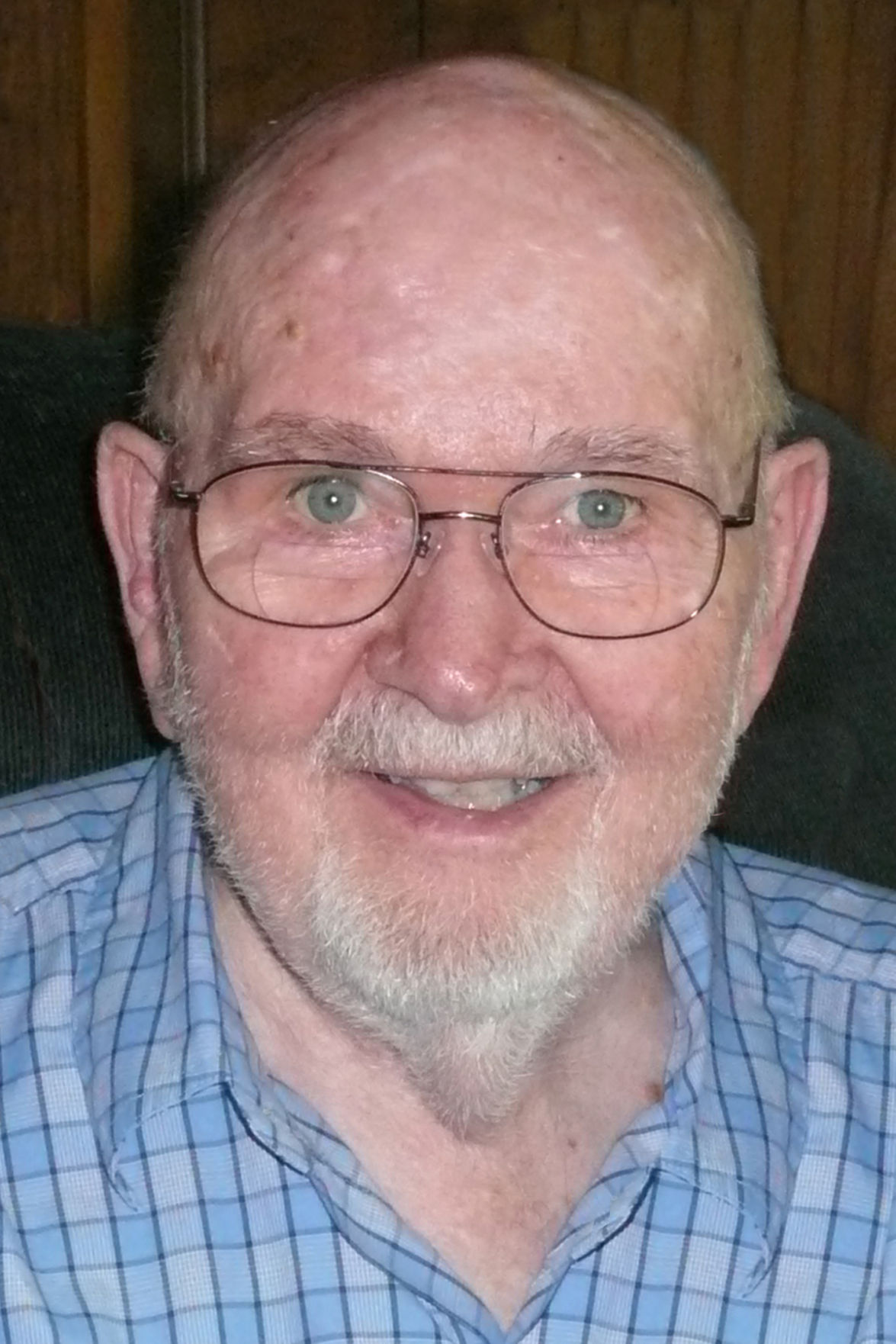 James Stanley Baird, 86, a Fort Atkinson artist and photographer for more than six decades, passed away peacefully Jan. 25, 2016, at St. Mary's Hospital in Madison, following complications from a heart attack.
James Stanley Baird, 86, a Fort Atkinson artist and photographer for more than six decades, passed away peacefully Jan. 25, 2016, at St. Mary's Hospital in Madison, following complications from a heart attack.Baird was born May 8, 1929, in Kenosha, the son of Stanley and Margaret (Wharrie) Baird. He began his love affair with art while growing up in Burlington, delicately working with pencils, pens, pastels and paint to draw landscapes, still-lifes, animals, cartoons and more. His family moved to Fort Atkinson in 1943 when Baird's father transferred to the local office of the Wisconsin Electric Power Company.
Baird attended Fort Atkinson High School where he was president of his junior class, president of Student Council his senior year and a football lineman under coach Forrest Perkins. While in high school he won honors in a National Scholastic magazine art contest conducted by the Carnegie Institute in Pittsburgh. His pen and ink entry entitled "Home Town" depicted Fort Atkinson's skyline.
Baird graduated from Fort Atkinson High School in 1947 and attended Whitewater State Teachers College (now the University of Wisconsin-Whitewater). While in Whitewater he studied etching under the late Leon Pescheret, a preeminent artist with a studio there. It was Pescheret's techniques that most influenced the skills Baird developed for his own artwork.
For three years Baird worked summers, weekends and after school at James Manufacturing Company, apprenticing under the late Gilbert Knoerr, the company's commercial artist. Baird's art and illustration skills landed him a job at Hoard's Dairyman magazine in March 1948. While hired as an artist, he also soon became a proficient photographer for the international dairy magazine.
Baird said the best decision he ever made was marrying Verna N. Miller from Milton Junction on June 18, 1950, at the First United Methodist Church in Fort Atkinson. She was a secretary, also employed by the W. D. Hoard and Sons Co. They enjoyed 62 years of marriage, with Verna preceding him in death on Nov. 6, 2012.
During his 45-year career with Hoard's Dairyman, Baird handled most of the Hoard's Dairyman magazine's layout and photography. He witnessed and participated in significant technology changes between his 1948 hiring and his 1993 retirement - changes in magazine printing, black-and-white and color photography, and dairying.
Over the years he drew hundreds of illustrations and took photographs to accompany magazine articles. He took nearly 700 cover pictures for the magazine, photographing dairy cattle in pastures, barns and shows in 37 states. The rules for the covers were very specific; each cover had to have a cow in it.
Baird was especially well-known for his cow paintings and postcards of the "Foster Mothers of the Human Race" and for his holiday covers on the Hoard's Dairyman magazine and the Daily Jefferson County Union. These covers usually featured church, nativity or rural scenes and showcased them in the beautiful but painstaking technique known as scratchboard. These intricate drawings quickly became signature Christmas cards for both publications and reflected Baird's life-long attention to detail.
In all, Baird created more than 100 scratchboard pictures, other drawings, acrylic and oil paintings, etchings, and pastels at work and in his spare time. Those original art pieces, and prints from them, grace the homes of family, friends and businesses across the U.S., plus hang in the Hoard Historical Museum, the National Dairy Shrine, and many churches, businesses and schools in the area.
For many years, Baird participated in the annual Hoard Museum Art Show. His entries in the adult professional historical category helped document scenes of Fort Atkinson's past and present. He often won awards for his meticulous artwork - subjects as diverse as an old horse to "Camelot," a painting where he creatively rearranged Fort Atkinson landmarks.
As far back as 1951 he and the late Fran Klitze co-chaired the first Rural Art Association exhibit held in Fort Atkinson. In 1985, the then relatively new Fort Atkinson Arts Council selected Baird for its first one-man, week-long art exhibit.
Outside of his professional career, Baird volunteered at the Hoard Historical Museum and the National Dairy Shrine. He designed the original dairy exhibit at the museum and was involved in the development of the National Dairy Shrine. Baird obtained and donated many dairying artifacts housed in the Dairy Shrine and authored a booklet, "Dairy Collectibles" in which he documented and illustrated his findings about early dairy implements.
He served on the Historical Society board of directors in the 1980s, developed the Tool & Trades exhibit for the museum, and was an avid collector of antique tools, some handmade by his grandfather. He often donned his work apron, fired up a forge, and demonstrated his love of blacksmithing and antique tools to family and museum visitors.
Baird served in the Wisconsin National Guard for over 15 years. The state Guard unit was called to active duty during the Berlin Crisis in 1961 and he was based at Fort Lewis, Washington, for a year.
The patience and steadiness he had as an artist also were valuable traits on the rifle range. As a member of the military and later as a civilian, he won many state and national medals, trophies and commendations for marksmanship. He was a U.S. Army Distinguished Rifleman, a Wisconsin high-power rifle champion, a National Guard national champion, member of the prestigious "President's Hundred" group of military marksmen, and twice was selected for the Sixth U.S. Army Rifle Team. In the early 1960s he was a principal leader and instructor for the Black Hawk Junior Rifle Club, teaching 12- to 18-year-olds the proper handling of firearms as well as marksmanship.
In October 2012 Baird received National Dairy Shrine's highest honor, the Pioneer award, for his contributions to the dairy industry. Baird's other honors included the 1990 Lions' Club Distinguished Community Service Award, a Certificate of Service to the Community by the City of Fort Atkinson, the 1988 Fort Atkinson Historical Society Volunteer of the Year, and a 1971 Wisconservation Club Conservation Award.
Baird was a member of the First United Methodist Church, American Legion, Jaycees, and the Midwest Tool Collector's Association. Until a year ago he served as a long-time trustee of his ancestors' historical home church, the Reformed Presbyterian Church of Vernon in Big Bend, Wis., which no longer is in operation but opens once annually for a service.
Survivors include his three children, Perry (Marcia) Baird, Paula (Rick) Schroeder and Steven (Lois) Baird, all of Fort Atkinson; grandchildren and great-grandchildren, Colin (Stacey) Baird and daughters, Charlotte and Ella of Luxemburg, Wis.; Bridget (Sira) Nsibirwa and children, Gavin and Gabriella, of Fort Atkinson; Drew (Christine) Baird and children, Zachary and Hannah, of Belton, Texas; Lesley Baird of Windsor; Hillary Baird of Fort Atkinson, and Joelle Baird (Adam Sherman) of Grand Canyon Village, Ariz.
Also stepgrandchildren and stepgreat-grandchildren, Jason (Erin) Rauber and children Blake, Atley and Hadyn, Emily Rauber and daughter Lily, Angelina Nsibirwa, Lisa Schroeder and son Colton, and Terri (Sean) Connery and daughters, Alysha and Hailey; sister, Margaret (Carl) Birk of Fort Atkinson; sister-in-law, Donna Baird of Oconto; cousin, Nancy (Dennis) Prahl of Appleton; nieces, nephews, other relatives and special friends.
Baird also was preceded in death by his parents; two brothers, Robert and William Baird; and sister, Mary.
Memorial services will be held on Tuesday, Feb. 2, at 11 a.m., at the First United Methodist Church, 320 S. Main St. in Fort Atkinson, with the Rev. Russell Frees officiating. A luncheon will follow in fellowship hall.
Visitation will take place at the church from 9:30 a.m. until the time of services.
Burial will be at a later date at the Reformed Presbyterian Church of Vernon Cemetery, Big Bend, where four generations of the Baird family are buried.
Nitardy Funeral Home in Fort Atkinson is assisting the family, www.nitardyfuneralhome.com.
In lieu of flowers, those considering memorials may wish to direct them to the Reformed Presbyterian Church of Vernon (sent in the church name to Trustee Perry Baird) or the First United Methodist Church in Fort Atkinson.
The family extends its gratitude to the wonderful staff and friends at Black Hawk Senior Residence where Jim made his home the past two years, and also to Shelley and Randy Hoefs for helping Jim and Verna in many ways through the years.
Friends, colleagues recall Baird with fondness
Friends and associates today were remembering with great fondness and respect the life and artistic achievements of James S. Baird, longtime artist and photographer at Hoard's Dairyman magazine, who passed away Monday at age 86.
A 1947 graduate of Fort Atkinson High School, Baird had just completed his first year of college in Whitewater when he was hired as art director for the worldwide dairy magazine. He ended up staying for 44 years, retiring in 1993.
Velveteen Rabbit 300x250 ROS In Story
Brian Knox, president of W.D. Hoard and Sons Co., recalled that Jim really was one of the "backbones" of Hoard's Dairyman magazine and the W.D. Hoard and Sons company during his entire tenure.
"He really was the last of the ‘old guard' at Hoard's," Knox observed. "He came here under Bill Hoard and worked with Bill Knox, Bud Kerschensteiner and Gene Meyer the entire time he was here.
"There was a lot of mutual respect among them all," he added. "It was a hard-working and collegial, but fun, time to work here."
Knox noted that after retiring, Jim certainly wasn't a stranger to the company, as he continued to create scratchboard Christmas covers for the magazine, among many other endeavors, and kept active with the Hoard Historical Museum and National Dairy Shrine.
The company president also pointed out that Jim was a nationally-known sharpshooter - a fact of which most people probably are not aware.
"I can remember, as a kid, my dad (Bill Knox) asking, ‘What if Jim goes to the 1960 or 1964 Olympics?" Knox said. "In between (those Olympics), however, he got called up and sent to Washington for National Guard duty during the Berlin Crisis."
As art director, he said, Jim was "an incredible perfectionist - except, perhaps, with his spelling" - who bridged the eras when artwork was hand-produced to now largely computer-generated.
"Jim did technological transitions, several while he was here, from airbrushes to computers," Knox said. "And he did the transition from traveling the country taking photographs for the magazine."
In summary, he stated, "Jim was one of those quiet guys with a dry sense of humor. He was a really nice guy whom everybody is going to greatly miss."
Echoing that sentiment was Corey Geiger, managing editor of Hoard's Dairyman, who characterized Jim as being among the giants of the dairy industry through his artistic ingenuity and selfless contributions.
"Jim Baird is a dairy industry icon whose creations are embedded in the hearts and minds of the readers of Hoard's Dairyman, as well as dairy history's timeline," Geiger commented. "Jim's passing marks the closing of a remarkable era for Hoard's Dairyman in which Bill Knox, Gene Meyer and Jim Baird together dedicated over 180 years of service to the readers of Hoard's Dairyman found around the world."
And then there are his cow drawings, Geiger said, that latter which helped revolutionize the dairy industry.
"His drawings transformed dairy cattle breeding in the advent of linear scoring of dairy cattle," Geiger noted. "In those works, Jim matched scientific theory with vision. Those sketches are still in use today by numerous breed organizations and cattle genetic organizations."
Locally, he said, Jim's legacy will be the beautiful National Dairy Shrine Museum that he helped create through his artistic vision.
"Those exhibits captivate dairy enthusiasts from around the world, and it's a reason so many travel to Fort Atkinson," Geiger remarked. "And, of course, Jim's scratchboard creations (used on Christmas issue covers) and paintings forever captured area churches and life.
"We will miss Jim's steady hand and artistic vision," he concluded. "He was a mentor to many younger members of our staff."
Speaking of the museum, the Hoard Historical Museum and National Dairy Shrine were a second home for Jim, who designed and executed the original dairy exhibit at the museum.
"Jim Baird was one of the most important individuals in the development of the National Dairy Shrine Museum in Fort Atkinson," National Dairy Shrine Executive Director David Selner said.
He noted that Jim designed most of the displays in the museum, acquired many of the dairy artifacts, and kept meticulous records of the artifacts and the history of the dairy industry. Himself a collector of antique handtools, Jim donated much of his personal collection of dairy artifacts to the Dairy Shrine, and then continued to locate and purchase items for the collection.
Jim served four years on the Fort Atkinson Historical Society Board of Directors and, in effect, served as the Dairy Shrine's local manager for many years.
Selner added that Jim obtained many of the artifacts related to dairying that are housed in the Dairy Shrine, and authored a booklet, "Dairy Collectibles," in which he documented and illustrated his findings about early dairy implements.
"His beautiful artistic works are proudly displayed in many parts of the museum," the director said. "He was the sole person responsible for creating the look and feel of the museum."
Besides his involvement with the museum, Selner pointed out that Jim was admired greatly for his talents throughout the dairy world, recognized with a 4-E award in 2000 and a Dairy Shrine Pioneer recognition in 2012.
"He is now permanently a member of the National Dairy Hall of Fame," Selner said. "The talents of Jim Baird in developing the museum will never be duplicated but will always be greatly appreciated by all who visit the National Dairy Shrine museum. Truly a rare talent and one of the cornerstones of National Dairy Shrine in Fort Atkinson."
Current Hoard Historical Museum director Merrilee Lee said that she considers herself fortunate to have had the opportunity to meet Jim in recent years.
"Jim shared his artistic talent with the world and we are grateful for his gift," she said. "Our thoughts are with his family."
Former museum director Kori Oberle noted that she, too, was sorry to hear of Jim's passing.
"I'm grateful our paths crossed at the Hoard Historical Museum and National Dairy Shrine," she said. "I wish the world had more people in it like Jim. My condolences to his immediate and extended family."
Former museum director Sue Hartwick agreed.
"Jim was a mainstay at the Hoard Museum and National Dairy Shrine's Visitors Center, equally comfortable on both sides of the aisle," Hartwick said. "In fact, I always loved the days that Jim was our greeter as he could talk to our visitors so comprehensively about both our local history and the dairy industry."
She noted that Jim and his wife, Verna, were part of the Hoard's Helpers team, volunteers who came in to the museum on a regular basis for a potluck lunch before spending the afternoon working on various projects.
"As I'm sure most everyone knows, Jim was an amazing artist who regularly contributed pieces to the Mary Hoard Art Show, and just as regularly took home awards, especially the popular choice award," Hartwick said.
She echoed Selner's recollections of Jim's efforts in installing the museum's first dairy exhibit that helped convince the National Dairy Shrine to locate its visitors center in Fort Atkinson.
"Once the Dairy Shrine built the new addition in 1980, Jim volunteered his time to manage and maintain the exhibits," Hartwick said. "He later brought Bob Wulfkuhle in to help him with the job, and all of us who worked in the building enjoyed listening to the two of them banter back and forth while they worked. Jim was a talented, modest, soft-spoken man whose quiet work had a big impact on our community. His legacy will live on at the museum."
Meanwhile, Marlene Brunner, retired editorial coordinator with Hoard's Dairyman who worked alongside Jim for 40 of her 58 years at the magazine, described him as a perfectionist of the highest order.
"I found him to be very, very much a perfectionist and an artist that one probably will not find again in a long time," Brunner commented, emphasizing that his artwork didn't involve computers and was all done by hand. "When he did all the Christmas (scratchboard) drawings, he did them all at home, not at the office, because it was very time-consuming work. The December (Hoard's Dairyman December) issue always had one of his scratchboards on its cover."
Often, she said, Jim would come out to her Jefferson farm and take photographs of her driving her horse-drawn sleigh to use as a guide for his scratchboard drawings.
"On three scratchboards of his, he used my horse, Ginger, and sleigh as a model - he put them in different settings (on the covers)," Brunner recalled. "One of his (drawings) had the driver sitting on the wrong side, however - he's supposed to sit on the right side so he has access to that whip if he needed it. Somebody who remembered horse-drawn sleighs actually wrote in (to point out the inaccuracy)."
Above all, she considered Jim more than merely a co-worker; he was a friend.
"He was so professional and such a gentleman - such a gentleman you wouldn't believe," Brunner remarked. "And so talented!"
Moreover, she said, Jim was incredibly humble.
"There was no ego in him at all; he was very, very humble," Brunner said, noting that he mostly set up the entire National Dairy Shrine exhibit by himself. "He never would brag - he was just very, very humble. The fact that he did all those scratchboard drawings at home, on his own time - and not on company time - says it all."
Every once in a while, she said, Jim would present her with a print of one of his paintings.
"I do paintings, too, and would go up and show them to Jim so he would know what I was entering in the (Mary Hoard) art show," Brunner said. "We had a good relationship toward the end because I'd stop by from time to time and see him at the Black Hawk Senior Residence."
Jim was so proud of his family, she said, especially while at the assisted living facility in Fort Atkinson.
"He would talk about his grandchildren, and have pictures of his grandchildren that he would show to me," Brunner said. "He was always very, very proud of his family."
Brunner shared some more humorous moments of their friendship. While Jim seldom was given to temperamental outbursts, she recalls one day before air-conditioning had been installed in the company that the heat got the better of him.
"I remember he came storming out of his office, complaining: ‘It's too hot to work!'" Brunner laughed.
Despite his artistic aptitude, she said, spelling wasn't one of Jim's strong suits.
"He couldn't spell," Brunner stated. "He always asked (co-workers) how to spell words. We'd tease him about that. He was always poking his head around the corner, asking, ‘How do you spell that?'"
She remembered the huge garden that Jim's late wife, Verna, planted and tended every year.
"She always wanted a lot of horse manure (for fertilizer)," Brunner, a horse owner, said. "So every Spring, I'd go down there with a load of horse manure. Jim didn't want that much, but I'd go in and we'd unload it, and they'd spread it around. Every year for 15 or 20 years or so, I'd bring them a load of horse manure."
Brunner also remembered planning Jim's retirement party all by herself.
"It was the biggest retirement party anybody had had at Fairview Inn," Brunner said. "I think Jim liked it and was quite pleased with it."
Also taking time to reflect today on Jim Baird was Elvi Kau, another retired associate at Hoard's Dairyman.
"I was sad to hear of Jim Baird's passing," she said. "It was a great privilege to work with Jim for 15 years during my time as book editor at Hoard's Dairyman.
"Along with anyone who received the Dairyman as a subscriber, Jim's consistently beautiful cover photos will always be remembered, and, of course, he shot many of the photos to illustrate the articles inside," Kau commented. "Yet, I remember him telling me that when he first started as the magazine's art director, he hardly had any experience as a photographer. His then-boss, Bill Hoard, told Jim that he was to learn photography, and Jim surely did."
In this capacity, Kau said, she fondly remembers riding with Jim on days when there was a fresh snowfall to shoot winter photos for the Hoard's Dairyman calendar, which she produced.
"The winter issues featured the Hoard's Cow Judging Contest, so there was no need for winter scenes," Kau recalled. "I drove, and Jim looked for the farmsteads. This was above and beyond his job, but he was happy to help, and I was so grateful."
Of course, she said, Jim often went above and beyond his job as art director.
"There was no winter photograph for the December issue of the magazine because, on his own time, outside of office hours, Jim would produce a scratchboard illustration for this issue, often a scene or church from the area," Kau pointed out.
And it was Jim's collecting of dairy artifacts that was the genesis of the National Dairy Shrine, a part of the Hoard Historical Museum, she said, adding it was appropriate that the Shrine honored Jim for his efforts in developing its exhibits.
"But my point here is that without any honor or recognition, Jim worked and produced, and never expected a pat on the back," Kau stated. "He did it because of his dedication to Hoard's and the dairy industry. He produced great work and was always modest about it.
"Hoard's really lost a great employee when Jim retired," Kau concluded. "I join with his family and the community in mourning his loss."
Lastly, Jim Mode, 74, of rural Jefferson, said he knew Jim prior to their serving in the Wisconsin?Army National Guard together.
"He had used me as a model for the cover of a book Hoard's did called ‘Careers in Agriculture,' which pointed out that there was more to agriculture than just farming," Mode recalled. "I was about 15 or 16 at the time. I know I have a copy of it somewhere."
He said he joined the National Guard as a private first class at age 17 in the summer of 1959 and that Jim was his platoon sergeant.
"He was really a good guy to have as a platoon sergeant," Mode noted. "He respected you and treated you fairly."
In 1961, when called up for active duty at Fort Lewis, Wash., during the Berlin Crisis, he said, Jim tried out for the Guard's rifle team and was one of its best marksmen.
"He traveled around the country shooting in matches for the?Army and representing the team from Fort Lewis," Mode said of Jim. "So while we were in training, we didn't see much of him because he was gone a lot of the time competing."
Mode, who advanced to specialist rank and later was promoted to sergeant E-5 while at Fort Lewis, said he and Jim were in infantry outfits together.
"We started out with large-unit exercises and did trainings designed for the European war-type concept," Mode recalled. "We then went on to more small-unit training squads and platoons done in the rainforest area (of Washington State). I guess they (commanders) were looking at the Vietnam situation."
While at Fort Lewis, he said, Jim usually would give him a good-natured hard time as he had him in the rifle platoon's weapons squad.
"I considered him a good friend,"?Mode said. "We'd meet every once in a while at different functions. I was always happy to see him and have a conversation with him, even though there was quite a bit of difference in our age.
"Jim was really a heck of a good guy and a tremendous artist with the Hoard's Dairyman, and a great photographer," he concluded.
"He will be missed by a great many people."
Source: Daily Jefferson County Union
1.27.2016

